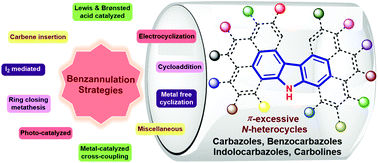Benzannulation strategies for the synthesis of carbazoles, indolocarbazoles, benzocarbazoles, and carbolines
Abstract
Nitrogen-containing π-excessive aromatic heterocycles, in particular, carbazoles, indolocarbazoles, benzocarbazoles, and carbolines have been considered the fundamental backbone of organic chemistry for many decades due to their omnipresence in natural products, alkaloids, terpenes, marketed drugs, medicinally active compounds, organic materials, etc. Together with their ever-increasing importance, there has been a multi-dimensional significant advancement in the last decade towards their synthesis. This review presents an analysis of several exciting classical benzannulation and non-classical benzannulation approaches developed in the past decade (2010–2020) for the construction of carbazoles, indolocarbazoles, benzocarbazoles, and carbolines. The principal aim of this review is the detailed discussion of several fascinating mechanistic pathways together with the role of numerous key reagents and catalysts. Furthermore, the efficacy of these numerous benzannulation techniques towards the downstream synthesis of natural alkaloids, organic materials, and medicinally important scaffolds together with upcoming key challenges in this field are also covered in detail.

- This article is part of the themed collection: 2021 Organic Chemistry Frontiers Review-type Articles


 Please wait while we load your content...
Please wait while we load your content...